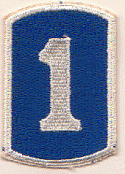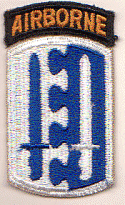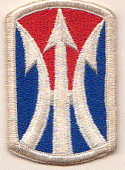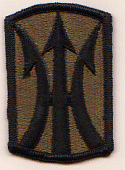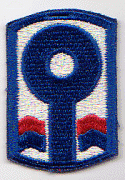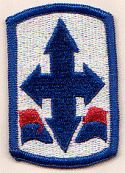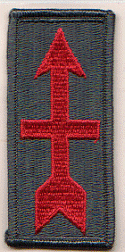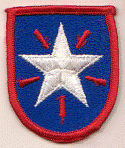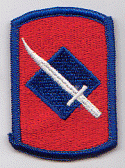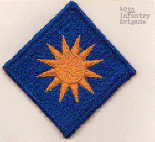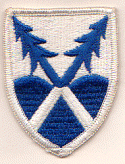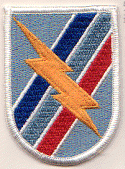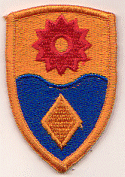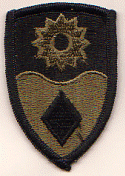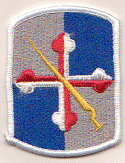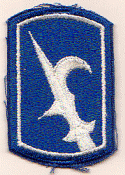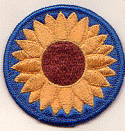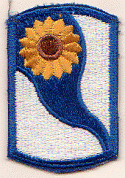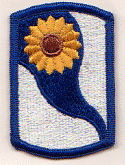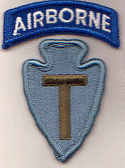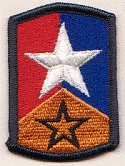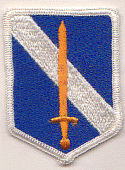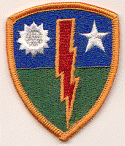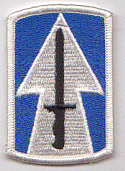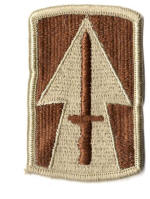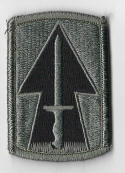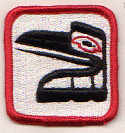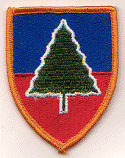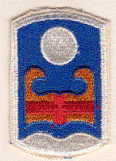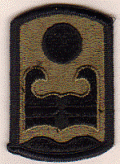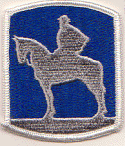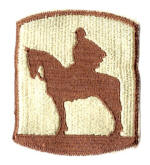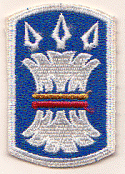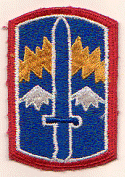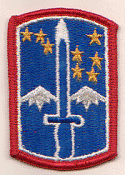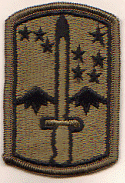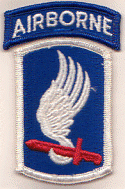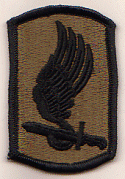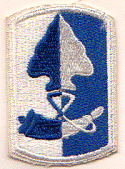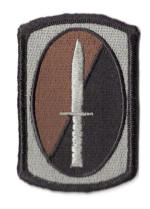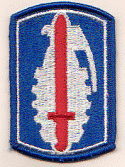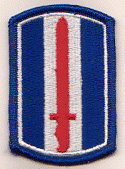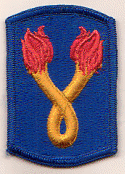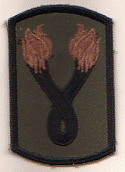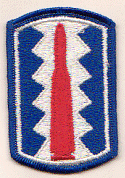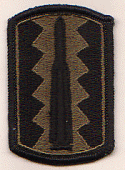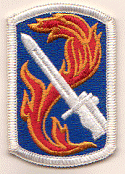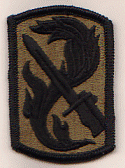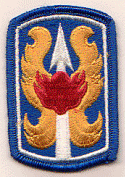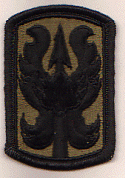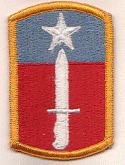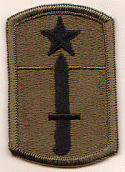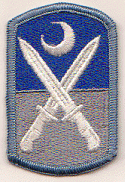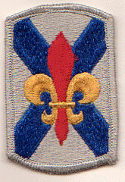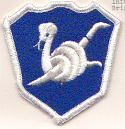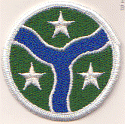The USArmyPatches.com original site
first went online April 21st, 2004.
This entire site and all
related pages are Copyright 2004 - 2011. All Rights Reserved.
All Images are Copyrighted by USArmyPatches.com and permission is required
to
download any image for commercial purposes.
To satisfy non-commercial use copyright requirements, give credit and a link to "www.usarmypatches.com"
below the image for any images
downloaded for non-commercial use on the web.
The following information is from http://www.globalsecurity.org/military/agency/army/1id-1bde.htm
1st Brigade Combat Team, 1st Infantry Division
The 1st Brigade Combat Team, 1st Infantry Division (Mechanized), was one of the Army's 2 oldest divisional brigades. It was first organized on 24 May 1917 as the 1st Infantry Brigade under the newly formed First Expeditionary force, which soon evolved to become the 1st Infantry Division (the Big Red One). The Brigade fought valiantly during a host of campaigns during World War I: Lorraine, Picardy, Montdidier-Noyon, St. Mihiel, Aisne-Marne, and Meuse-Argonne. After garrison duty in the US during the 1920s and the 1930s it was inactivated in 1939, when the Army discontinued its brigade-based divisional structure.
The 1st Brigade was reactivated in July 1958 at Fort Benning, Georgia, as the 1st Infantry Brigade. In 1964, it rejoined the 1st Infantry Division, this time at Fort Riley, Kansas, and was redesignated as the 1st Brigade ("Devil Brigade") of the Big Red One.
The 1st brigade deployed with the Division to the Republic of Vietnam in 1965. For nearly 5 years, the 1st Infantry Division soldiers battled against an aggressive enemy. The 1st Infantry Division returned to Fort Riley in April 1970. Over 3,000 soldiers of the Big Red One died in action. Eleven Medals of Honor winners were added to the rolls. The 1st Brigade served in 10 campaigns encompassing 24 battles.
In 1990, it deployed with the Big Red One to Southwest Asia in support of Operation Desert Shield/Desert Storm. Leading the breach of Iraqi defenses on 24 February 1991, the Brigade actively fought and destroyed the enemy in the 3 campaigns involving the Defense of Saudi Arabia and the Liberation of Kuwait. In recognition of their contributions, each of the Brigade's battalions received the Valorous Unit Citation.
The 1st and 2nd Brigades of the 1st Infantry Division (Mechanized) were the only 2 divisional brigades in the US Army authorized their own distinctive unit insignia. Since 1999 the 1st Brigade had grown into a dual-based, stand-alone structure consisting of 6 battalions and 3 company-sized units. It was subordinate to the Commanding General of Fort Riley, Kansas, for training, readiness, and deployability. Under this direction, the Brigade prepared, among other things, for the eventuality of possible future operations with its parent division, then headquartered in Wuerzburg, Germany. The Brigade's presence at Fort Riley continued, in reduced fashion, the long-standing relationship of the Big Red One to Fort Riley.
On 23 July 2003, US Army Forces Command alerted the 1st Brigade for deployment to the Iraq Theater of Operations in support of Operation Iraqi Freedom. The Brigade deployed its main body starting on 2 September 2003, closing in Kuwait by 11 September 2003. Initially attached to the 82nd Airborne Division, the Brigade occupied Area of Operations Topeka and conducted Transition of Authority with the 3rd Squadron, 3rd Armored Cavalry Regiment on 26 September 2003.
On 20 March 2004, Combined Joint Task Force 7 (CJTF-7) attached 1st Brigade, 1st Infantry Division (Mechanized) to the 1st Marine Division to continue its offensive operations in the Topeka Area of Operations. For 12 months, the Brigade's offensive operations killed 541 insurgents, wounded 101 more, and detained over 2,081 enemy fighters, including the capture of 18 High Value Targets and 20 foreign fighters. The Brigade withstood hundreds of small arms and RPG engagements, as well as over 550 IED attacks. Disrupting the enemy's ability to conduct operations, the Brigade's cache searches and exploitations captured 41 heavy machine guns, 175 RPG launchers, 3,134 mortar and artillery rounds, 1,781 rockets, and 17 surface-to-air missiles. In addition to combat operations, the Brigade formed and trained the 60th Iraqi National Guard Brigade, including the 500th, 501st, and 502nd ING Battalions. 1st Brigade also sponsored over 23.8 million dollars in civil projects in the Al Anbar province. The Brigade returned to Fort Riley from 14-26 September 2004.
In January 2005 the 1st Brigade was again called upon to prepare for deployment for OIF. The Brigade spent the majority of 2005 refitting and training for deployment in fall 2005. This training culminated with the Brigade's deployment to the Joint Readiness Training Center in August and September 2005. In January 2006 the 1st Brigade received a mission change and began restructuring in order to better train Military Transition Teams for their deployment. The 1st Brigade was also tasked with providing deployable security force elements that could move anywhere the Army might wanted them to be. Approximately 2,000 Soldiers from the Brigade deployed fall 2006 as SECFOR companies.
In the summer of 2009, as part of the Brigade Combat Team's modular transformation, 1st Battalion, 34th Armor Regiment was inactivated and its personnel reflagged as 4th Squadron, 4th Cavalry Regiment.
The following information is from http://www.globalsecurity.org/military/agency/army/32in-bde.htm
32nd Infantry
Brigade (Light) (Separate)
"Red Arrow"
 The 32nd Infantry Brigade (Light) (Separate) is
Wisconsin's 3,900
soldiers
of Wisconsin's largest Army National Guard unit.
Until September 2001, the brigade was a
mechanized unit assigned as part of the
Minnesota-based 34th Infantry Division.
The 32nd Infantry Brigade (Light) (Separate) is
Wisconsin's 3,900
soldiers
of Wisconsin's largest Army National Guard unit.
Until September 2001, the brigade was a
mechanized unit assigned as part of the
Minnesota-based 34th Infantry Division.
The 32nd began
transforming in September 2001 into a separate
light infantry brigade. By shedding its heavy
tracked vehicles -
tanks,
self-propelled howitzers and armored personnel
carriers - the brigade will gain the agility
favored by the leadership of the
Army.
In 1967, the 32nd Division - by then made up entirely of Wisconsin units - was deactivated and reorganized as the 32nd Separate Infantry Brigade. In 1971, the brigade was converted to mechanized infantry. In 1997, the 32nd reorganized from a separate to a divisional brigade, reducing in the process the staff of its headquarters from 300 down to 85.
After it is converted back to light infantry, Army officials plan to designate the 32nd an "enhanced" brigade, eligible for a higher level of funding and other resources than most National Guard brigades receive. Changing the brigade's shape to fit the profile of a light brigade will also mean significant benefits for the unit and for the state, including more than $6 million a year in additional federal funds to operate units and provide training and logistics support. This should also translate into an increase in the number of physical assets, such as trucks and scoop loaders, which become available to the state in an emergency.
The following information is from http://www.globalsecurity.org/military/agency/army/49ar-div-36bde.htm
36th Brigade
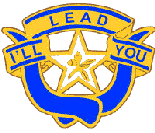 The
lineage and honors of the 36th Brigade can be
traced back to the 36th
Infantry
Division,
which was originally organized at Camp Bowie
(Fort Worth), TX, on 18 July 1917, and which
drew from units of the Texas and
Oklahoma
National
Guard.
The
lineage and honors of the 36th Brigade can be
traced back to the 36th
Infantry
Division,
which was originally organized at Camp Bowie
(Fort Worth), TX, on 18 July 1917, and which
drew from units of the Texas and
Oklahoma
National
Guard.
After taking part in operations in France during World War I, the unit was reorganized into 2 separate units, an "all Texas" division, while its Oklahoma units sub-components joined to form part of the 45th Infantry Division.
The Division was mobilized on 25 November 1940, and placed on active duty station at Camp Bowie, before transferring overseas to North Africa and Italy. In the process, the 36th became the first American combat division to land in Europe. Taking part in combat operations in Italy and Southern France, the unit had accumulated seven campaign streamers, taken part in two assault landings and had 14 of its members receive the Medal of Honor.
Upon its return home, the unit was reorganized as part of the Texas National Guard and was deactivated in 1968. With the inactivation of the 49th Armored Division, the 36th Brigade assumed the lineage and honors of the 36th Infantry Division.
Residents East Texas woke to a rumble that shook homes and rattled windows. The disturbance was not a roll of thunder but multiple sonic booms from the fallen space shuttle Columbia during its failed re-entry into the earth's atmosphere during the early morning on the first day of February, 2003. Texas responded immediately to the disaster when Gov. Rick Perry called several hundred National Guard service members to duty to assist the recovery effort under the operational name of "Big Thicket."
Large military troop-carrying vehicles filled with soldiers rolled out from various armories throughout East Texas and converged on the impacted counties along the Texas-Louisiana border to help in the massive joint recovery operation.
The Texas soldiers worked with the Federal Emergency Management Agency, the National Aeronautics and Space Administration and other federal, state and local agencies during this emergency operation. Upon receiving their marching orders, members of the Guard quickly deployed to start searching the likely impact area that focused primarily on six East Texas counties, encompassing thousands of square miles along the shuttle flight path.
Col. Eddy M. Spurgin, task force commander of the 36th Infantry Brigade Combat Team, 49th Armored Division, commended his soldiers for their diligence and motivation on a mission that he deemed noble and worthwhile. " I would like to let every Texan know that we are all citizen-soldiers, and that just a few days ago, we were all at our civilian jobs and going about our everyday business when we were called up to serve after the shuttle tragedy," Spurgin said. Some of the local soldiers who live in the area had been on duty since the first day of the catastrophe - helping local law enforcement officials secure shuttle material that descended from stratosphere only hours before.
The following information is from http://www.globalsecurity.org/military/agency/army/40id.htm
40th Infantry Division
(Mechanized)
"Sunburst"
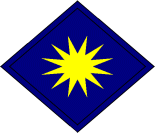
The 40th ("Sunshine") Division was originally organized at Camp Kearney, near San Diego, California, September 16, 1917, and was composed of National Guard organizations of the states of Arizona, California, Colorado, Nevada, New Mexico, and Utah. The Division enjoyed a continuity of policy and tradition, due to the command of Major General Frederick S. Strong, United States Army
On 13 January 1974, the California Army National Guard was reorganized. The three separate brigades, the 40th and 49th Infantry, and the 40th Armored were eliminated, and the 40th Infantry Division (Mechanized) was organized and remains in existence today. The Division was converted from its historic role as Infantry to Armor and redesignated the 40th Armored Division on 1 July 1954.
In 1960, the Division combat units were reorganized under the Combat Arms Regimental Systems (CARS), and then in 1963, was reorganized under the ROAD concept which changed the combat commands to brigades. On 1 December 1967, a major reorganization of the National Guard reduced the Guard to eight combat divisions, the 40th Armored Division being one of the casualties. On 29 January 1968, the Division was eliminated and the 40th Infantry Brigade and 40th Armored Brigade were organized
As of July 2006 as part of the Army National Guard's modularization process, the 40th Infantry Division was scheduled to reorganize into 5 Brigade Combat Teams and one Aviation Brigade. According to the National Guard, the 40th Infantry Division would consist of the 40th Infantry Brigade Combat Team, the 41st Infantry Brigade Combat Team, the 29th Infantry Brigade Combat Team, the 207th Infantry Brigade Combat Team, the 81st Armored Brigade Combat Team, and the 40th Aviation Brigade. National guard units from California, Oregon, Hawaii, Arizona, Washington, Alaska, New Mexico, Indiana, Nebraska, and Guam became part of the 40th Infantry Division once modularization was complete.
The following information is from http://www.globalsecurity.org/military/agency/army/41in-bde.htm
41st Infantry
Brigade Combat Team
"Jungleers"
41st
Infantry Brigade (Light) (Separate/Enhanced)
 In FY 2006,
as part of the Army's transformation towards a
modular force, the 41st Infantry
Brigade
(Light) (Separate) was redesignated the 41st
Infantry
Brigade
Combat
Team. The organization of the unit was also
adjusted to reflect this change.
In FY 2006,
as part of the Army's transformation towards a
modular force, the 41st Infantry
Brigade
(Light) (Separate) was redesignated the 41st
Infantry
Brigade
Combat
Team. The organization of the unit was also
adjusted to reflect this change.
The state mission of the 41st Infantry Brigade Combat Team is to, on order of the Governor, or the local commander, unit mobilize and deploy in response to emergency situations in the State of Oregon. Its federal mission is to, on order, mobilize, deploy to theater of operation, occupy assembly area, conduct combat operations, redeploy, and demobilize.
The history of the 41st Infantry Brigade Combat Team can be traced back to 1887 when the Summers Law established the Oregon National Guard. In 1917, the 41st Infantry Division was formed (Named the Sunset Division). Oregon National Guard infantry, field artillery and cavalry units were sent to Camp Green, North Carolina, where, together with other National Guard units from the northwestern states, they were formed into the 41st Division.
In 1975, the 41st Separate Infantry Brigade became "Roundout" to the 7th Infantry Division. It was designated in 1994 as "Enhanced". The unit was selected as one of the ESB's to form the Integrated Division in 1998. In June 1998, the 41st Separate Infantry Brigade spent two weeks at the JRTC, the Joint Readiness Training Center, the Army's advanced academy for light infantry, at Fort Polk in central Louisiana.
The following information is from http://www.globalsecurity.org/military/agency/army/48in-bde.htm
48th Infantry
Brigade (Enhanced) (Mechanized)
"Old Gray Bonnet"
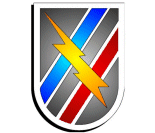 The mission
of the 48th
Infantry
Brigade
(Separate) (Mechanized), is to mobilize, conduct
post mobilization training, and deploy rapidly
to a contingency area by air, sea, and land to
conduct mobile combined offensive and defensive
operations worldwide.
The mission
of the 48th
Infantry
Brigade
(Separate) (Mechanized), is to mobilize, conduct
post mobilization training, and deploy rapidly
to a contingency area by air, sea, and land to
conduct mobile combined offensive and defensive
operations worldwide.
The 48th Infantry Brigade (Enhanced) (Mechanized) was originally organized on April 23, 1825, at Macon as the Macon Volunteers, Georgia Volunteer Militia. It mustered into Federal service on February 18, 1836, at Picolata, FL, as Captain Seymor's Company, 1st Battalion Georgia Volunteers.
The unit was mustered into Confederate service on April 20, 1861 at Macon, GA. It reorganized on April 11, 1872 at Macon, GA, as the Macon Volunteers. It was redesignated on December 21, 1899, as Georgia State Troopers; and on October 1, 1905 as the Georgia National Guard.
The unit was drafted into Federal Service in August 1917 as Company B, 151st Machine Gun Battalion, an element of the 42nd Division. It demobilized in May 1919 at Camp Gordon, GA.
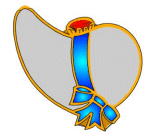 It
was inducted into Federal service on September
16, 1940 at Macon, and was and redesignated on
February 24, 1942 as the 30th Cavalry
Reconnaissance Troop while remaining assigned to
the
30th
Infantry
Division.
It inactivated on November 17, 1945.
It
was inducted into Federal service on September
16, 1940 at Macon, and was and redesignated on
February 24, 1942 as the 30th Cavalry
Reconnaissance Troop while remaining assigned to
the
30th
Infantry
Division.
It inactivated on November 17, 1945.
From 1945 to 1973, the Brigade underwent a series of redesignations culminating in its current form, the 48th Infantry Brigade. The unit was inducted into Federal service on November 30th, 1990 at Fort Stewart, GA. It demobilized on April 10, 1991 at Fort Stewart, GA.
More than 4,500 members of the unit were mobilized in 1990 to participate in Desert Storm. The unit successfully completed the most intensive training ever conducted at the Army's National Training Center in California, and was first and only National Guard combat brigade validated as combat ready for the Gulf War. The conflict ended before the brigade was employed in the Persian Gulf.
In June 1999, the 48th Infantry Brigade (Mechanized) became part of the newly re-flagged 24th Infantry Division.
The unit also has a training associate relationship with the 3rd Infantry Division (Mechanized).
Elements of the 48th Infantry Brigade deployed to Bosnia-Herzegovina for Stabilization Force (SFOR) Rotation 9 to provide support operations for Task Force Eagle (United States contingent to United Nations Operations in support of Dayton Peace Accord). The SFOR9 rotation was scheduled from April to October 2001. The Georgia units were mobilized under a Presidential Selective Reserve Call Up. While other National Guard units have participated in the Bosnia operations in the past, the 48th Infantry Brigade (Mechanized) will be among the first National Guard combat units of this size and capability to take over such a large and significant portion of this mission.
On April 20, 2006, at Ft. Stewart, GA, more than 4,000 members of the Georgia National Guard’s 48th Infantry Brigade returned home after a year of combat operations in Iraq. The April 20th arrival marked the first of nearly a dozen flights over the subsequent four weeks that brought the soldiers back to Georgia.
The following information is from http://www.globalsecurity.org/military/agency/army/29id-3bde.htm
58th
Brigade Combat Team - 29th Infantry Division
(Infantry)
3rd Brigade - 29th
Infantry Division (Light)
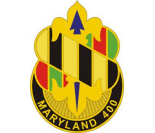
The 58th Brigade Combat Team (Infantry) of the 29th Infantry Division is formerly known as the 3rd Brigade, 29th Infantry Division
The 3rd Brigade, 29th Infantry Division, was originally organized on 22 November 1909 in the Maryland National Guard at Baltimore as Company A, Hospital Corps. It was reorganized and redesignated on 19 February 1913 as Field Hospital No. 1.
The unit was mustered into federal service on 29 June 1916 and mustered out on 6 January 1917. It was again mustered into federal service on 25 July 1917, and drafted into federal service on 5 August 1917. It was reorganized and redesignated on 10 October 1917 as Field Hospital Company No. 113, an element of the 29th Division. It was demobilized on 4 June 1919 at Camp Meade, MD.
Reorganized and federally recognized on 12 April 1921 in the Maryland National Guard at Baltimore as Hospital Company No. 1, the unit was redesignated on 10 January 1922 as the 113th Hospital Company, an element of the 29th Division. It was reorganized and redesignated on 1 January 1937 as Company I, 104th Medical Regiment, an element of the 29th Division (later redesignated as the 29th Infantry Division).
The unit was redesignated on 1 December 1939 as Company H, 104th Medical Regiment and inducted into federal service on 3 February 1941 at Baltimore. It was subsequently reorganized and redesignated on 12 March 1942 as the Clearing Company, 104th Medical Battalion. It inactivated on 17 January 1946 at Camp Kilmer, NJy.
The unit was reorganized and federally recognized on 30 March 1948 at Baltimore. It was reorganized and redesignated on 1 March 1959 as Company B, 104th Medical Battalion, and redesignated again on 1 March 1963 as Company C, 104th Medical Battalion. The unit concurrently relocated to Pikesville. It relocated again on 22 August 1964 to Baltimore.
It converted and was redesignated on 21 January 1968 as part of Company A, 228th Supply and Transport Battalion, an element of the 28th Infantry Division. It was ordered into active federal service on 7 April 1968 at Baltimore; released from active federal service on 12 April 1968 and reverted to state control. It was reorganized and redesignated on 1 December 1971 as Detachment 2, Company A, 228th Supply and Transport Battalion.
The unit was relieved on 1 April 1975 from assignment to the 28th Infantry Division and was concurrently consolidated with Headquarters Company, 58th Brigade, 28th Infantry Division; Detachment 2, Company B, 228th Supply and Transport Battalion; Detachment 2, 28th Military Police Company; Detachment 2, 28th Finance Company (organized and federally recognized on 17 November 1959 at Baltimore); and Detachment 2, 28th Adjutant General Company (organized and federally recognized on 1 December 1971 at Baltimore). The consolidated unit was reorganized and redesignated as Headquarters Company, 58th Infantry Brigade. It relocated on 1 October 1981 to Pikesville.
The unit reorganized and was redesignated on 1 July 1985 as Headquarters and Headquarters Company, 3d Brigade, 29th Infantry Division.
The following information is from http://www.globalsecurity.org/military/agency/army/67in-bde.htm
67th Area Support Group
67th
Infantry Brigade
As of late January 2002, the 67th Infantry Brigade had been redesignated as the 67th Area Support Group.
The 195th Armor Battalion of the Nebraska National Guard, a subordinate unit of the 67th Infantry Brigade, deactivated on Sunday September 2, 2001. Its elements were redesignated as the 734th Transportation Battalion (Motor Support).
The 134th Infantry Regiment, Nebraska's only infantry unit, inactivated on August 18, 2001. Its component, the 1st battalion was to be reorganized into transportation and chemical reconnaissance and decontamination units.
As of mid-2001, the process which had started in central Nebraska was four years along, and the regiment's 1-195th Armor and 67th Forward Support battalions were in various stages of transition.
The following information is from http://www.globalsecurity.org/military/agency/army/172inbde.htm
172nd Infantry Brigade
(Separate)
172nd Stryker Brigade Combat Team
"Blackhawks"
"Arctic Wolves"
"Snow Hawks"
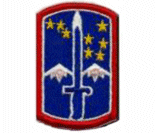 The
172nd Infantry Brigade (Separate) was first
constituted on 5 August 1917 in the National
Army as the 172nd Infantry Brigade. The unit was
organized on 25 August 1917 at Camp Grant, in
Rockford, Illinois and assigned to the 86th
Division.
The
172nd Infantry Brigade (Separate) was first
constituted on 5 August 1917 in the National
Army as the 172nd Infantry Brigade. The unit was
organized on 25 August 1917 at Camp Grant, in
Rockford, Illinois and assigned to the 86th
Division.As part of the 86th Division, the 172nd Infantry Brigade arrived in Bordeaux, France, for combat duty in September 1918. At that time, the Brigade consisted of the 343rd and 344th Infantry Battalions, and the 333rd Machine Gun Battalion. Its combat record during the war was sketchy. Known for sure was that the 86th Division was depleted by calls for replacements at the front, and what remained of it was sent to Le Mans, France. The 86th Division returned to the United States in January 1919. The 172nd Infantry Brigade received a campaign streamer without inscription for participation in World War I and was disbanded in January 1919 at Camp Grant.
The Brigade was reconstituted on 24 June 1921 in the Organized Reserves, again as an element of the 86th Division, and was organized in January 1922 in Springfield, Illinois. The unit went through several redesignations, including on 23 March 1925, as Headquarters and Headquarters Company, 172nd Brigade, and on 24 August 1936 as Headquarters and Headquarters Company, 172nd Infantry Brigade.
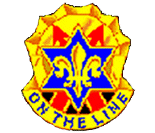 The
Brigade Headquarters was converted and
redesignated as the 3rd platoon, 86th
Reconnaissance Troop, 86th Division on 31 March
1942. The unit was mobilized and reorganized at
Camp Howze, Texas, on 15 December 1942 as the
86th Cavalry Reconnaissance Troop. It was
reorganized and redesignated again on 5 August
1943 as the 86th Reconnaissance Troop,
Mechanized. For the majority of the US
involvement in World War II the unit remained
stateside, participating in the Third US Army #5
Louisiana Maneuvers in 1943, among other
exercises. The 86th Reconnaissance Troop moved
to Camp Livingston, Louisiana in January 1944
and to Camp Coke, California in September 1944.
It moved to Camp San Luis Obispo, California for
amphibious training in December 1944.
The
Brigade Headquarters was converted and
redesignated as the 3rd platoon, 86th
Reconnaissance Troop, 86th Division on 31 March
1942. The unit was mobilized and reorganized at
Camp Howze, Texas, on 15 December 1942 as the
86th Cavalry Reconnaissance Troop. It was
reorganized and redesignated again on 5 August
1943 as the 86th Reconnaissance Troop,
Mechanized. For the majority of the US
involvement in World War II the unit remained
stateside, participating in the Third US Army #5
Louisiana Maneuvers in 1943, among other
exercises. The 86th Reconnaissance Troop moved
to Camp Livingston, Louisiana in January 1944
and to Camp Coke, California in September 1944.
It moved to Camp San Luis Obispo, California for
amphibious training in December 1944.
In addition, prior to 2005, the 172nd Infantry Brigade (Separate) had been nominally considered to be a component of the 10th Mountain Division at Fort Drum, New York, as its round out brigade, part of the structure for Force XXI light divisions. This also connected the Brigade nominally to XVIII Airborne Corps at Fort Bragg, North Carolina. However, this alignment ended when 10th Mountain Division began its own modular transformation and stood up organic 3rd and 4th Brigade Combat Teams.
In August 2005, the 172nd Brigade Combat Team deployed to Iraq in support of Operation Iraqi Freedom. The unit deployed to Mosul, Iraq. Its tour was to have ended on 27 July 2006, but the US Army unexpectedly extended its deployment until the end of November 2006.
After its return from Iraq, on 14 December 2006, the 172nd Brigade Combat Team was inactivated and reflagged as the 1st Brigade Combat Team, 25th Infantry Division. In March 2008, the 2nd Brigade, 1st Infantry Division in Germany was inactivated and reflagged as the 172nd Infantry Brigade (Separate) as part of a realignment of US forces in Germany and the transformation of the 1st Infantry Division to the US Army's modular force structure. 7 units in total from the 2nd Brigade, 1st Infantry were reflagged. Headquarters and Headquarters Company, 2nd Brigade, 1st Infantry became Headquarters and Headquarters Company, 172nd Infantry Brigade. 1-18th Infantry and 1-26th Infantry were reflagged as 1-2nd Infantry and 2-28th Infantry respectively. 1-77th Armor was reflagged as 3-66th Armor, while 1-7th Field Artillery was reflagged as 1-77th Field Artillery. E Troop, 4th Cavalry was reflagged as E Troop, 5th Cavalry. Lastly, the 299th Forward Support Battalion was reflagged as the 172nd Support Battalion. The 172nd Infantry Brigade, organized a again as a pre-modular separate brigade, also gained 9th Engineer Battalion, 504th Military Intelligence Company, and 57th Signal Company.
The following information is from http://www.globalsecurity.org/military/agency/army/173abnbde.htm
173rd Airborne
Brigade Combat Team
173rd Airborne Brigade (Separate)
"Sky Soldiers"
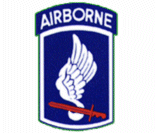 As
of June 2006, the 173rd
Airborne
Brigade
was in the process of being reorganized as part
of the US Army's modularization process. As of
January 2006, the 1st Battalion, 503rd Infantry
Regiment was reassigned to the 173rd Airborne
Brigade. The 2nd Battalion, 503rd Infantry
Regiment stayed remain with
the
Brigade
Combat Team. On 8 June 2006, the 1st Squadron,
91st Cavalry Regiment, the 4th Battalion, 319th
Field Artillery Regiment, and the 173rd
Special
Troops
Battalion
were all activated as part of the 173rd Airborne
Brigade Combat Team.
As
of June 2006, the 173rd
Airborne
Brigade
was in the process of being reorganized as part
of the US Army's modularization process. As of
January 2006, the 1st Battalion, 503rd Infantry
Regiment was reassigned to the 173rd Airborne
Brigade. The 2nd Battalion, 503rd Infantry
Regiment stayed remain with
the
Brigade
Combat Team. On 8 June 2006, the 1st Squadron,
91st Cavalry Regiment, the 4th Battalion, 319th
Field Artillery Regiment, and the 173rd
Special
Troops
Battalion
were all activated as part of the 173rd Airborne
Brigade Combat Team.
The 173rd Airborne Brigade was activated on the island of Okinawa on 26 March 1963. From its beginning, it proved to be an aggressive and unique unit led by (then) Brigadier General Ellis W. Williamson who established realistic training throughout the Pacific Region. The "Sky Soldiers," as the Nationalist Chinese paratroopers called the 173rd Brigade, made thousands of parachute jumps in a dozen different Pacific area countries.
The 173rd on Okinawa was called the "Fire Brigade" meaning that it was available to be dropped in any of the Southeast Asian countries if needed. To call Reveille, the Battalion Commander of the 1-503rd Infantry, Colonel "Rawhide" Boland, erected a number of very large speakers from which the song "Rawhide" by Frankie Laine (also the theme song to the television show of the same name) was blasted all over the camp. Every morning, the Sky Soldiers of the 173rd's 1-503rd Infantry were rousted from their bunks by the blaring words, "head 'em up, move 'em out, Rawhide" or something to that effect. The entire 173rd Airborne Brigade soon became known as "the Herd."
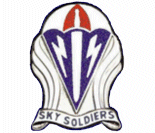 The
Brigade was the first complete US Army Unit sent
to the Republic of South Vietnam. The 1st and
2nd
Battalion
of the 503rd Parachute Infantry Regiment were
the first US Army units to be sent to the
Republic of South Vietnam along with the 3rd
Battalion of the 319th Artillery. They were well
supported by their own
Support
Battalion
and Troop E, 17th Cavalry Regiment and D
Company, 16th Armor Battalion. The First
Battalion of the Royal Australian Regiment, and
the 161st Field Battery of the Royal New Zealand
Army were later attached to the Brigade during
the first year. In Late August, 1966, the 173rd
received another
Infantry
Battalion,
the 4th Battalion, 503rd Infantry Regiment which
arrived from Ft. Campbell, Kentucky. The 3rd
Battalion, 503rd Parachute Infantry joined the
Brigade at Tuy Hoa in September 1967 following
their reactivation and training at Fort Bragg,
North Carolina.
The
Brigade was the first complete US Army Unit sent
to the Republic of South Vietnam. The 1st and
2nd
Battalion
of the 503rd Parachute Infantry Regiment were
the first US Army units to be sent to the
Republic of South Vietnam along with the 3rd
Battalion of the 319th Artillery. They were well
supported by their own
Support
Battalion
and Troop E, 17th Cavalry Regiment and D
Company, 16th Armor Battalion. The First
Battalion of the Royal Australian Regiment, and
the 161st Field Battery of the Royal New Zealand
Army were later attached to the Brigade during
the first year. In Late August, 1966, the 173rd
received another
Infantry
Battalion,
the 4th Battalion, 503rd Infantry Regiment which
arrived from Ft. Campbell, Kentucky. The 3rd
Battalion, 503rd Parachute Infantry joined the
Brigade at Tuy Hoa in September 1967 following
their reactivation and training at Fort Bragg,
North Carolina.
During more than 6 years of nearly continuous combat in Vietnam, the Brigade earned 14 campaign streamers and 4 unit citations, 13 Medal of Honor recipients, 137 Distinguished Service Crosses, more than 6,000 Purple Hearts and the only Combat Parachute Assault of the war. Sadly, more than 1,700 names of 173rd Brigade's soldiers are inscribed on the Vietnam Memorial Wall.
The following information is from http://www.globalsecurity.org/military/agency/army/151fa-bde.htm
218th Infantry Brigade (Heavy Separate)
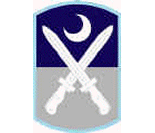 As part of the Army's transformation towards a
modular force, in 2005, the composition of the 35th Infantry
Division was changed. The 218th Infantry Brigade stood down in
the 24th Division, and stood up in the 35th Division
As part of the Army's transformation towards a
modular force, in 2005, the composition of the 35th Infantry
Division was changed. The 218th Infantry Brigade stood down in
the 24th Division, and stood up in the 35th Division
The 218th Heavy Separate Brigade is the largest Major Subordinate Command in South Carolina. It is one of the 15 Enhanced Readiness Brigades in the Army National Guard. Enhanced Readiness Brigades are the highest priority combat formations in the National Guard.
Congressman John Spratt secured $100 million in funding in 1997 and 1998 to upgrade M2A2 Bradley Fighting Vehicles for the 118th Mechanized Infantry, which is headquartered in Newberry and has companies in Chester, Winnsboro, and Gaffney. For his staunch support of the National Guard, the National Guard Association of the United States awarded Congressman John Spratt one of its highest honors, the Charles Dick Medal of Merit. In accepting, Spratt said his support for the Guard comes naturally, because he knows so many "first-rate citizen-soldiers" who serve in the South Carolina National Guard. Spratt views the Guard as a cost-effective way of keeping combat-ready forces. But for the Guard to be combat-ready, he believes its units have to be on parity with their parent units in the regular Army when it comes to weapons and equipment.
Significantly, Congressional initiatives in 1997 and 1998 accelerated this Brigade's modernization by programming defense dollars for upgrading its Bradley Infantry Fighting Vehicles from the M2A0 model to the M2A2 model that provides enhanced crew protection and capabilities. The Brigade's tanks (M1A1 Abrams) were already on a par with those used by the active Army. The Brigade's artillery battalion is programmed for modernization in 2001.
The 218th is one of three Army Guard enhanced maneuver brigades that comprise the Army's 24th Infantry Division, headquartered at Fort Riley, Kan., that was reactivated in June 1999. The two other brigades are located in North Carolina and Georgia. Nearly 10 years after the Persian Gulf War, the 218th is part of Army's new 'integrated' 24th Infantry Division, which in its previous life helped liberate Kuwait. It is considered an example of how closely active and reserve components are now working together.
For the 218th Brigade Combat Team, the weeks of July 2000 were crucial. The soldiers spent two years preparing for their unit's first full-scale training rotation in southern California. There is no better way to replicate the fog of war than at the National Training Center. The brigade, supported by nearly 2,000 more citizen-soldiers in the Palmetto State Task Force, trained in many ways to pull off what was said to be the largest peacetime deployment of National Guard forces in history. More than $21 million was budgeted for the entire exercise, South Carolina Guard officials reported. Although South Carolina has fielded the bulk of the force, citizen-soldiers and airmen from 26 other states were engaged in the cross-country mission that will ended 30 July 2000. More than 1,800 tanks, armored fighting vehicles and other pieces of equipment were hauled from South Carolina to California on railroad cars and trucks. Seven Apache attack helicopters were flown down from Idaho to beef up the brigade's 373-soldier aviation task force. Still other helicopters were flown from the East Coast on C-5 cargo planes. The vast array of ground vehicles were unloaded in Yermo, Calif., and convoyed across the desert to Fort Irwin for two weeks.

